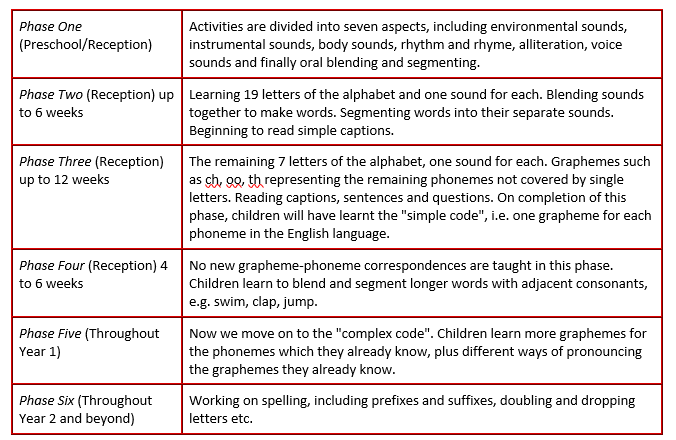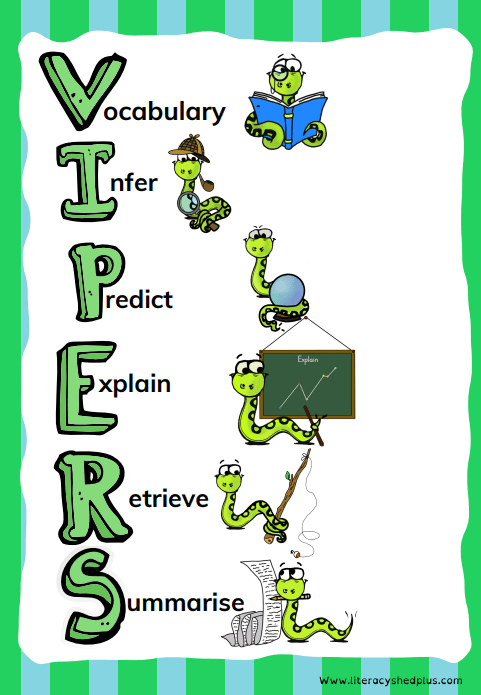Phonics and Reading
Phonics and Reading at St Mary’s
The programmes of study for reading at Key Stages 1 and 2 consist of word reading (decoding) and comprehension (understanding).
Skilled word reading involves both the speedy working out of unfamiliar printed words (decoding), and the speedy recognition of familiar printed words. Children need to understand that the letters on the page represent the sounds in spoken words.
At St Mary’s this is taught through a daily Phonics lesson in all Foundation and Key Stage 1 classes. Phonics is planned and taught using the Governments Letters and Sounds teaching programme.
Letters and sounds are taught in phases 1 to 6, each phase builds on the last. The table below explains each phase.
(Table taken from www.lettersandsounds.com )
As well as a secure phonic knowledge the children require good comprehension of what they are reading. Good comprehension draws on knowledge of vocabulary and grammar, and knowledge of the world. Comprehension skills develop through pupils’ experience of high-quality discussion with the teacher, as well as from reading and discussing a range of stories, poems and non-fiction texts.
At St Mary’s pupils are encouraged to read widely across both fiction and non-fiction to develop their knowledge of themselves and the world they live in, to establish an appreciation and love of reading, and to gain knowledge across the curriculum. Reading widely and often increases pupils’ vocabulary because they encounter words they would rarely hear or use in everyday speech. Reading also feeds pupils’ imagination and opens up a treasure house of wonder and joy for curious young minds.
At St Mary’s children have access to a wide choice of books including published schemes and free choice books for enjoyment. We use a variety of published schemes to build the children’s reading skill, enjoyment and fluency these include the following; Big Cat, Rising stars, Oxford Reading Tree and Bug Club which are all book aligned into our Phonics phases and book band colours. These are:
At St Mary’s reading takes many forms:
- Guided Reading/ Whole class reading- at least 2-3 times a week, the children will work as a whole class or in smaller groups to read a text together. These sessions have a comprehension focus and the discussion of the text and answers is crucial to the children’s development of their reading skills. Within these sessions the children use the reading VIPERS to support and develop their skills.
- Home Reading – All children are provided with reading book to take home and read to parents, this book is matched to their phonic phase and should be able to be read accurately and with fluency. A reading record will accompany each book and will act as a communication tool between school and home. Each child in EYFS and KS1 will also choose a library book to read for pleasure.
- In KS2 the children continue to work through the book bands but the focus here is reading for pleasure, therefore we support the children in accessing books that make them keen to read.
- Shared Reading – Frequent opportunities for children to read aloud as a class with the teacher modelling, using a range of books, big books and the interactive whiteboard.
- Class Novels/ Books- children have a daily opportunity to listen to and discuss stories or class novels as appropriate.
- Class Reading Area- Each class has a specific reading area where the children have access to a range of books to encourage the children to read for enjoyment.
- Library - Children can access the school library in school time.
Useful links
Articulation of phonemes: https://www.youtube.com/watch?v=BqhXUW_v-1s
Websites for children to play games within phonics phases: www.phonicsplay.co.uk , www.ictgames.com and https://www.teachyourmonster.org/
Remember children are never too young to develop their reading skills!
Watch here...http://www.youtube.com/watch?v=qU97IXT8MIs
At St Mary's we are following the Red Rose Letters and Sounds programme, this is a systematic, synthetic phonics planning programme using the letters and sounds approach. Within the programme the children will learn to read and write through their recognition of letters and the sounds they make and then develop the skills of blending (to read) and segmenting (to write). The children learn to write each letter of the alphabet correctly and consistently using a 'patter' for how to write them, this is below...
More general information about Phonics here... Phonics Presentation for Parents.ppt

Class 3 were the first winners of the Reading Rave, back in 2021! Since then the children have thoroughly enjoyed competing to be the winners to enjoy tasty treats whilst listening to music and reading!!



Our incentive to read whenever you can is still going strong!
We encourage reading several times a week (every day if you can).
The single most important factor to reaching those aspirations we have happily, is reading.
Finding what our children love to read can sometimes be a challenge for reluctant readers but there are lots of options out there for different interests.
No matter how frantic life gets, and no matter how stressful and time starved we are, the bedtime read is always a lovely calming time for children, reading their school books or their own things, and being read to also. It can be part of a routine and is the most easily managed element of homework through a winding down routine. So please, for our younger children, lets give them opportunities to read throughout the week, and for our older children, l
et's encourage them to read different things for enjoyment, and no one is ever too old to be read to!
In class, children will keep a record of how many times they have read on a simple chart. Older children can maintain their chart themselves, younger children can have this done collectively as a class. To check that the children have read, they could tell us about it, write a review, and most importantly, you can message the teacher on Class Dojo to say that they have read.
The class with the highest number of reads that week gets a Friday afternoon Reading Rave! This is in the school library! The children will be able to
read a book of their choice whilst listen to music, and there may even be a special snack! But to get the reading rave, each person in the class has to do their bit and enjoy reading in the days leading up to it!!
Here is an example of the chart. It will be maintained in class, and parents can interact through Class Dojo to inform us of when and what the children are reading.
As always, if you have images of the children reading or examples of really exciting things like the latest issue of The Beano or an extract from an internet article - anything - please send in your photos through Class Dojo or email.
Reading at Home
The Education Endowment Foundation have provided these helpful tips for reading at home:
For EYFS and KS1
For Key Stage 2:
















